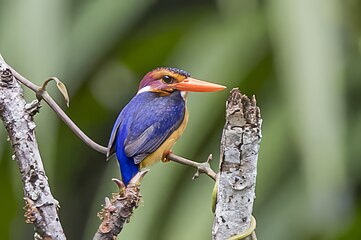| African pygmy kingfisher | |
|---|---|
 | |
| Scientific classification | |
| Domain: | Eukaryota |
| Kingdom: | Animalia |
| Phylum: | Chordata |
| Class: | Aves |
| Order: | Coraciiformes |
| Family: | Alcedinidae |
| Subfamily: | Alcedininae |
| Genus: | Ispidina |
| Species: | I. picta |
| Binomial name | |
| Ispidina picta (Boddaert, 1783) | |
| Subspecies | |
(See text) | |
 | |
| species range (IUCN) Year round resident Summer breeding visitor | |
| Synonyms | |
Ceyx pictus | |
The African pygmy kingfisher (Ispidina picta) is a small insectivorous kingfisher found in the Afrotropics, mostly in woodland habitats.



